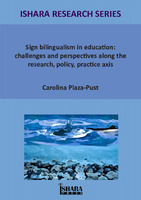Sign Bilingualism in education: challenges and perspectives along the research, policy, practice axis
| dc.contributor.author | Plaza-Pust, Carolina | |
| dc.date.accessioned | 2017-04-10 00:00:00 | |
| dc.date.accessioned | 2020-04-01T13:39:05Z | |
| dc.date.available | 2020-04-01T13:39:05Z | |
| dc.date.issued | 2016 | |
| dc.identifier | 627156 | |
| dc.identifier | OCN: 1030822630 | en_US |
| dc.identifier.issn | 2754-6276 | |
| dc.identifier.uri | http://library.oapen.org/handle/20.500.12657/31548 | |
| dc.description.abstract | From the first attempts at including sign language in deaf education until today, the status of sign language in deaf education has been marked by changing perspectives on deafness and the needs and abilities of deaf students. The perception of deaf individuals using a sign language and a spoken/written language as bilinguals is a relatively new phenomenon, and so is a bimodal bilingual conception of deaf education. The present work elaborates on the status of sign language in deaf education from a historical perspective with a view to tracing the current diversity of approaches to the education of deaf students. It portrays the developments leading to the establishment of sign bilingual education programmes in diverse social contexts, and discusses the major components and objectives of sign bilingual education based on a comparison of bilingual programmes implemented in Europe and North America. Commonly, the primary promotion of sign language is a characteristic of sign bilingual education conceptions at the programmatic level. Yet, how is this demand put into practice? Are the sign bilingual education programmes established in the last decades based on a common didactic conception? If they are not, what are the main dimensions of variation? And what does the variation observed reveal about the objectives pursued? The systematic analysis of the information gathered about the conception, establishment and evaluation of sign bilingual education reveals the advances that have been made and the challenges that remain regarding the promotion of sign bilingualism in deaf education in the areas of research, policy and practice. | |
| dc.language | English | |
| dc.relation.ispartofseries | Ishara Research Series | |
| dc.subject.classification | thema EDItEUR::C Language and Linguistics::CF Linguistics::CFZ Sign languages, Braille and other linguistic communication | en_US |
| dc.subject.other | sign bilingual education | |
| dc.subject.other | research-policy-practice axis | |
| dc.subject.other | deaf education | |
| dc.subject.other | sign language | |
| dc.subject.other | Deaf culture | |
| dc.subject.other | Hearing loss | |
| dc.subject.other | Multilingualism | |
| dc.subject.other | Oralism | |
| dc.subject.other | Spoken language | |
| dc.subject.other | Written language | |
| dc.title | Sign Bilingualism in education: challenges and perspectives along the research, policy, practice axis | |
| dc.type | book | |
| oapen.identifier.doi | 10.26530/OAPEN_627156 | |
| oapen.relation.isPublishedBy | c82dc3dd-b337-42c0-9e26-ba010f7f28e0 | |
| oapen.relation.isbn | 9780992922139 | |
| oapen.series.number | 3 | |
| oapen.pages | 114 | |
| oapen.place.publication | Lancaster, U.K. | |
| oapen.remark.public | Relevant Wikipedia pages: Bilingual education - https://en.wikipedia.org/wiki/Bilingual_education; Deaf culture - https://en.wikipedia.org/wiki/Deaf_culture; Deaf education - https://en.wikipedia.org/wiki/Deaf_education; Hearing loss - https://en.wikipedia.org/wiki/Hearing_loss; Multilingualism - https://en.wikipedia.org/wiki/Multilingualism; Oralism - https://en.wikipedia.org/wiki/Oralism; Sign language - https://en.wikipedia.org/wiki/Sign_language; Spoken language - https://en.wikipedia.org/wiki/Spoken_language; Written language - https://en.wikipedia.org/wiki/Written_language | |
| oapen.identifier.ocn | 1030822630 |

